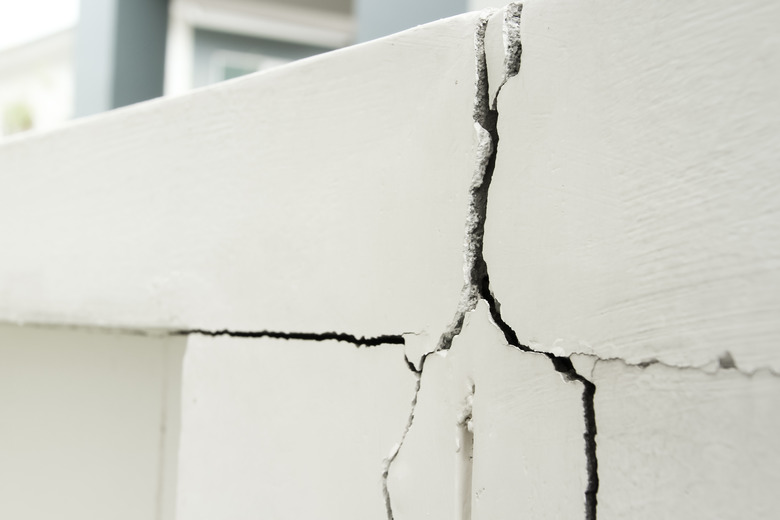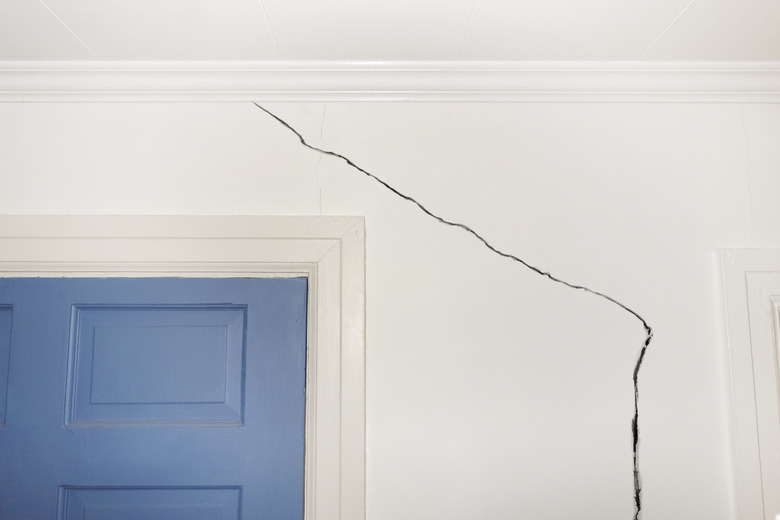How Much Does It Cost To Prevent And Repair Earthquake Damage? Here's What You Should Know
We may receive a commission on purchases made from links.
Earthquakes can cause significant damage to homes that aren't properly braced or reinforced. Even homes that do feature supportive construction can succumb to earthquake damage in the right circumstances. The cost of repairing earthquake damage starts at around a few hundred dollars. Sometimes, however, the entire home needs to be torn down and rebuilt due to seismic activity, which means the total cost varies widely based on the value of the home (as well as the deductible amount you pay and what percentage insurers will pay of the total cost).
Preventing or minimizing earthquake damage with retrofitted supports when possible is always more affordable than repairing the damage after it occurs. Learn more about what makes a home vulnerable to earthquake damage so you can assess your risk and make appropriate modifications before seismic events ever occur.
Tip
Minor earthquake damage costs about $150 to fix. The worst earthquake damage causes total building collapse, which means the cost to fix it equals the cost of building a new home.
Broken Gas and Utility Lines
Broken Gas and Utility Lines
Utility lines can break as the ground underneath them shifts or if a particular appliance in your home topples over from the tremor of a major earthquake. In the best-case scenario, a broken utility line can be repaired without too much excavation. For example, it costs anywhere from $150 to $600 to replace a gas line to a specific appliance. Replacing the entire length of a utility line requires excavation and extra materials and labor, which bumps the cost to around $3,000 to $25,000 depending on the length of the line and the type of utility (i.e., gas versus sewer).
A broken utility line can also cause secondary damage or create hazards that can lead to additional expensive repairs. For example, water damage can occur from a broken water line, and broken natural gas or sewer lines release harmful gases into the air. Gas leaks and/or electrical sparks can also cause a house fire. In fact, broken gas lines cause 25 percent of the fires that occur directly after an earthquake.
You can prevent some damage by anchoring all appliances to the floor or wall, which decreases the chance of them falling over or shifting position and snapping their water or gas connection. (This is a great solution for renters, who often can't control what their landlord does to protect the structure from damaging earthquakes.) Use flexible fittings whenever possible, including on gas appliances.
You can also learn how to manually shut off the utilities leading to your home to avoid water damage or fire. However, it may not be safe or convenient to reach the main shutoff valve in the event of an earthquake. Instead, consider installing an automatic gas or water shutoff valve on the customer-owned side of your meter to give yourself one less thing to worry about after an earthquake.
Masonry Earthquake Damage
Masonry Earthquake Damage
All kinds of masonry, including brick walls, chimneys, stone foundations, concrete walls or stucco walls, are at risk of crumbling and collapsing during an earthquake if they do not contain embedded steel reinforcement. To make matters worse, mortar can soften over time, which makes it even more susceptible to collapse with the slightest tremor. If masonry fails during an earthquake, your home may experience significant damage or total collapse. You and your family are also at a greater risk of being injured from falling walls. Even being outside during an earthquake can be dangerous if the chimney collapses or the walls fall outward.
Unless your home is relatively new and built with earthquake safety in mind, chances are that it's not reinforced. You should see evidence of end plates outside the brick wall if your home has already been retrofitted with additional supports. Sometimes, the hollow space between inside- and outside-facing brick or stone walls and foundations is filled with rebar and concrete. You can check by removing an exterior wall outlet to peek at the inner space. Reinforced chimneys may have metal ties evident in the attic.
Adding reinforcement to an existing wall, foundation or chimney is unfortunately an invasive and expensive procedure. It can cost around $2,000 to reinforce a chimney and around $15,000 to reinforce walls or foundations. However, without these proactive adjustments, your entire home could collapse during an earthquake, which means repairing the damage would cost the value of your home.
Home Foundation Movement or Collapse
Home Foundation Movement or Collapse
A home's foundation is another weak area prone to earthquake damage. Pier-and-post foundations are some of the flimsiest in terms of holding up during an earthquake. Concrete and stone wall foundations can collapse without sufficient reinforcement embedded in the material. Homes built on top of a crawl space with an unreinforced cripple wall can also collapse.
Regardless of how well the foundation is reinforced (and they often are in earthquake-prone areas), it will offer no protection unless it's anchored to the home. Without proper anchoring, the home will simply slide off the foundation. Finally, some homes have no foundation at all, which makes them extremely vulnerable to cracking or collapsing as the ground underneath them shifts during an earthquake.
The cost to anchor, reinforce or perhaps even replace the foundation can vary considerably. Adding diagonal blocks, plywood sheeting and anchor bolts to cripple walls could cost around $1,500 to $5,000. Bracing or replacing pier-and-post foundations could cost anywhere from $4,000 to $6,000. Concrete and masonry foundations are typically the most expensive to repair or replace. Of course, if the home falls off its foundation, the cost of repair will equal the value of the home.
Total Building Collapse
Total Building Collapse
"Soft-story" homes are prone to full collapse during an earthquake. A soft-story home has a living space built above a large, open room, like a garage or a commercial space. Without adequate bracing, the weak lower walls on these homes collapse, bringing the heavy upper levels with them. Projections have found that soft-story buildings will represent around two-thirds of homes that are too badly damaged for use after an earthquake on the San Andreas and Haywood faults in particular.
Homes built into hillsides may also constitute soft-story homes since the lower level is often a large space with few interior walls. Even homes that aren't soft-story can collapse simply because the home is built into a hillside, which destabilizes during an earthquake. Under normal circumstances, the dirt provides tension and bracing to the walls or foundation. As it falls away, the home destabilizes. Adding bracing to the walls of the home before an earthquake can help.
Plywood panels and steel straps can be used to reinforce the walls on soft-story homes or those built into hillsides. This can cost anywhere from $3,000 to $7,000 depending on the size and height of the home. If the entire home does collapse during an earthquake, the repair constitutes an entire rebuild and would equal the value of the home.
Damage to Home Belongings
Damage to Home Belongings
Even if you strap down your appliances, anchor your home to your foundation and add supplemental braces to your walls, your house will still rattle and shake during an earthquake. That means your belongings might get tossed around. Falling objects can hurt you or a loved one, so take steps to strap down heavy pieces of furniture, like bookcases or armoires.
Virtually everything — including your TV, paintings on the wall, kitchen cabinet doors, drawers and even knickknacks on display — can be secured in place with Velcro, sticky tape or a specialized product like QuakeHold. Benefits of preparing your belongings for an earthquake include increasing safety in your home as you seek shelter, reducing cleanup after the earthquake and mitigating the loss of items due to irreparable damage.
Personal property damage caused by an earthquake may not be covered by your insurance policy or extra earthquake coverage. Securing your belongings can potentially save you thousands of dollars in replacement costs depending on how much you own and how expensive it is.
Paying for Earthquake Prevention and Damage
Paying for Earthquake Prevention and Damage
Most homes vulnerable to earthquake damage need what's called a bolt-and-brace retrofit, which refers to foundation anchoring and bracing the walls. This expense is typically paid out of pocket. However, some grants are available, such as the Earthquake Brace + Bolt $3,000 grant offered by the California Earthquake Authority (CEA) and funded in part by the Federal Emergency Management Agency. To put that into perspective, the CEA estimates that most earthquake retrofitting costs approximately $3,000 to $7,000, so this grant could potentially cover all expenses.
Note that homeowners' insurance does not cover earthquake damage but may cover damage from a fire that stems from an earthquake. Many homeowners insurance policies also do not cover flood damage, which also represents a real threat after an earthquake. If you live in an area at high risk for earthquakes, consider purchasing separate earthquake insurance and/or a flood policy to help you rebuild your home.
Typically, earthquake insurance covers reactive payments and will not help you pay for a bolt-and-brace retrofit, but some do. For example, the CEA earthquake insurance policies offers policyholders up to a 25 percent discount on their monthly premiums if they complete a proper retrofit. Only specific houses are eligible for this discount. For example, your home must be built before 1980 and have a wood frame construction over a nonslab foundation.
Are There Earthquake-Resistant Buildings?
Are There Earthquake-Resistant Buildings?
There is such a thing as an earthquake-resistant building — for example, Los Angeles's U.S. Bank Tower can withstand an 8.3 magnitude earthquake despite being over 1,000 feet high, and San Francisco's Transamerica Pyramid survived a 7.1 magnitude earthquake despite being over 850 feet high. These skyscrapers are built with the same engineering that can help residential buildings to survive earthquakes: deep foundations built with reinforced concrete.
However, a new strategy involves building flexible foundations that move with the earth to absorb some of the shock of a quake. Other designs involve flexible steel cables embedded in the building's structure that allow it to sway when an earthquake hits. Then, an internal pulley system pulls the entire building back into position.
This engineering technology is still quite new, which means it won't be an affordable solution for most homeowners. Until then, concrete slab foundations and bolt-and-brace retrofits offer the best earthquake protection and benefit a wide variety of home designs.
Secondary Damage From Earthquakes
Secondary Damage From Earthquakes
It's wonderful if your home still stands after the initial tremors subside. However, the aftershocks can still be powerful enough to weaken your home, and other problems may appear, like tsunami waves, landslides or quick-sandlike conditions. These represent powerful forces of nature that you really cannot prevent unless you move to an entirely different location.
Learn about the post-earthquake risk factors in your area. For example, a tsunami wave is only a concern for people who live near the coast, but you could still experience flooding if you live downstream from a dam that breaks during the earthquake. Develop a worst-case-scenario emergency evacuation plan so that you are out of harm's way by the time the landslide, sinking or flooding occurs.
References
- Kompare It: Finding and Repairing a Gas Line Leak
- Fletch-Barney: How Much Does It Cost To Dig Up And Replace Sewer Line?
- Viatechnik: The Science Behind Earthquake-Proof Buildings
- QuakeHold: Protect Your Collectibles
- Federal Emergency Management Agency: FEMA Issues $1.2M Installment to California for Earthquake Protection
- Earthquake Brace + Bolt: Home
- ValuePenguin: Earthquake Insurance, Explained
- California Earthquake Authority: Does Your House Qualify for a CEA Policy Discount?
- Quake Busters: Housing Vulnerable to Damage in Earthquakes
- California Earthquake Authority: Benefits of Seismic Upgrades: Is Earthquake Retrofitting Worth It in CA?
- California Seismic Safety Commission: Homeowner's Guide to Earthquake Safety
- Fixr: How Much Does It Cost to Retrofit a Home for Earthquake Protection?
- HD Foundations: What Pier And Beam Foundation Repair Costs?


